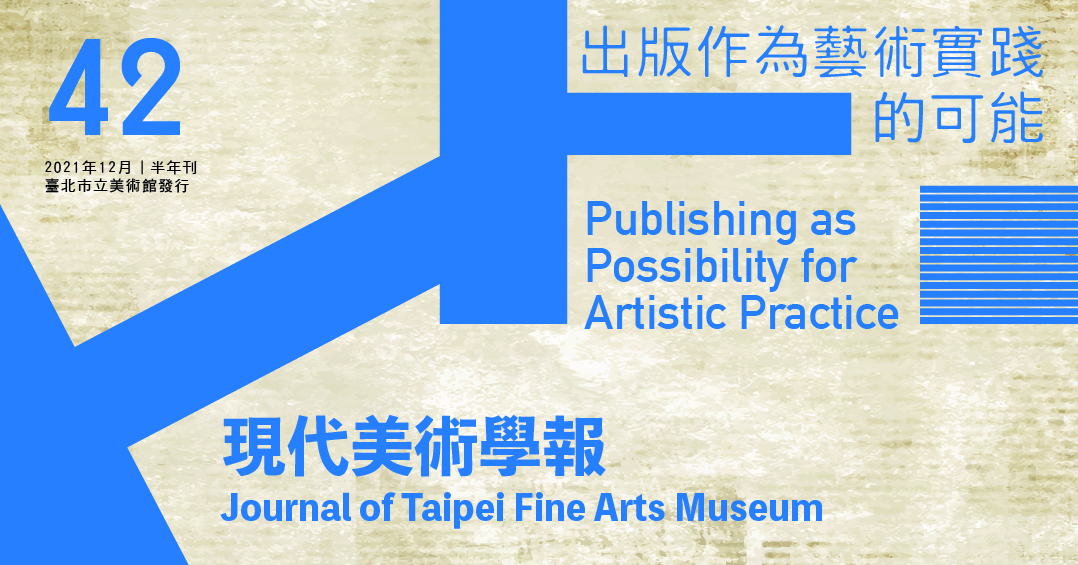| 摘要
出版作為藝術實踐的可能
2020 年起受全球疫情影響,許多藝術文化活動尋求不同的執行途徑,例如自2009 年起舉辦的「東京藝術書展」(Tokyo Art Book Fair,簡稱TABF)改為「虛擬藝術書展」(Virtual Art Book Fair,簡稱VABF),以線上互動網頁的形式作為書展介面。除了以原先預定展場「東京都現代美術館」為網頁空間之外,也結合各式圖像提供參展路徑,包括美術館展場內部的攤位、外部延伸的戶外展演、攤位空間的擺置設計、攤位上書作品及其他延伸作品的圖像等。
這樣的案例反映2020 年全球藝文活動中值得注意的媒介轉向。自2006 年起紐約非營利出版單位Printed Matter 於MoMA PS1 所舉辦的「紐約藝術書展」(NY Art Book Fair,簡稱NABF),陸續帶動世界其他座城市(如東京、曼谷、倫敦、上海、新加坡等)舉辦以「城市」為名的藝術書展,其中的策展模式與細節規劃大多延續NABF 的架構。當2020 年的VABF 以「Virtual」一字取代「Tokyo」,暗示著「城市」的名字被取代⸺「虛擬」不僅稀釋了城市之間的各別差異,凸顯當代社會中全球在地化的矛盾,亦模糊線上與線下的界線。另一方面,在藝術書展中,無論是藝術家書籍、攝影書、手工書、小誌(zine)等,書籍的「紙本」實體是這類書作品的重要元素。也因此,當虛擬書展中書作品是透過網路介面呈現,書的物理特質被壓縮為螢幕像素,更回應新媒體介入對於書的翻閱與遮蔽等面向,以及影像、圖像、後攝影等多重層疊與模糊的定義。
本期專題以「出版作為藝術實踐的可能」為提問,希望透過不同研究者的觀點,集結對於當代書文化現象的論述。在深度評論部分,中國獨立策展人何伊寧以〈作為攝影書作品的照片檔案:中國當代攝影書出版中「老照片」的回聲〉為題,首先回顧中國攝影出版於2010 至今的的發展與變化,進而分析中國當代攝影書中圍繞照片檔案的創作類型,並以唐景鋒的《顏姐》與石真的《悲劇,巧合與L.L.D.M 的雙重生活》為案例。南韓攝影研究學者Nayun Jang 在〈混血的名字:1960 年代韓國影像式論文的誕生〉一文中,以朱明德(Joo Myung-Duck)的攝影書《混血的名字》(The Mixed Names)為例,探討1960 年代南韓戰後攝影情況下,《混血的名字》作為以「影像式論文」(photo-essay)形式進行的攝影專題計畫,如何透過「攝影書」形式整合文字與照片,述說官方語境中忽略的狀況。台灣研究者謝佩君的〈倦怠未來:淺談Martine Stig 的《柯西視界》裡的科幻平庸〉則以2013 年出版的攝影書《柯西視界》為例,檢視科幻類型下的攝影書當中的影像編排、印製、攝影與電影的交集,並探討科幻文類如何對現狀進行反思。另外,簡妙如〈醒醒吧!台灣龐克小誌及小誌文化政治〉文章,則企圖連結國際龐克小誌與小誌文化運動的歷史脈絡,說明小誌文化中的反抗特質,並以2000 年前後台灣龐克小誌的發展,如何在獨立音樂場域當中擴張串連,重申小誌的批判性。
而在專題論文部分,沈裕昌〈圖書館與肥皂箱:對《跨域讀寫: 藝術中的圖書生態學》的跨域讀寫〉以2018 年在台北市立美術館中的展覽「跨域讀寫:藝術中的圖書生態學」的出版品為出發,從該展中11 位藝術家的創作與2位策展人的策劃作為方法,分析這個以藝術出版品為主體的展覽中,其展覽出版品中「主題是展覽,但不是也不會是展覽畫冊」的提問,探討「出版作為藝術實踐」的當代意義。洪芷寧〈當製書是創作也是秀異:初探臺灣近十年「小誌」與「藝術家的書」場域內外的敘述混戰〉一文以台灣近十年來的「藝術家的書」與「小誌」為題,以文化場域概念為取徑,分析兩種不同的「製書」實踐的重疊與分野。賴雯淑〈藝術家的書在陽明交大之教學藝術實踐〉則以自身於陽明交通大學應用藝術研究所的「藝術家的書」課程為例,以教學、實作、作品面向中,探討藝術家的書在教學與創作上的思考。
總體而言,本期專題針對藝術場域當中圍繞「書」的文化現象,透過深度評論與專題論文的集結,希望提出後數位文化中媒介思考的更多可能性,為持續定義的多元現狀中,建立新的感知模式。1
Abstract
Publishing as Possibility for Artistic Practice
From the outset of 2020, many art and cultural events have been seeking alternative ways of operation due to the pandemic. For instance, the Tokyo Art Book Fair (TABF) has been named as the Virtual Art Book Fair (VABF), taking an interactive website as its site. The original venue, the Museum of Contemporary Art Tokyo, hosted the fair in an online virtual space, which also combined a variety of images to offer access to the virtual exhibition, including the booths inside the museum, the outdoor performance, the design of the booth, and the photos of books and other publications of the booths.
Such a case reflects a significant medium shift of global art and cultural events in 2020. Since 2006, the New York Art Book Fair (NABF), organized by the New York-based non-profit publisher Printed Matter, has set the trend for other cities around the world (such as Tokyo, Bangkok, London, Shanghai, and Singapore) to organize art book fairs under the name of each “city,” continuing NABF’s curatorial model and structure. When the name “Tokyo” was replaced by the concept “Virtual” at the VABF in 2020, it implied that the “virtual” scene diminished the divide between cities, highlighting the contradictions of glocalization in contemporary society and blurring the boundaries between online and offline activities. On the other hand, physical “paper” hard copies are crucial elements of publications in various forms in art book fairs, including artist’s books, photobooks, hand-made books, and zines. Hence, when books were presented through online interfaces in a virtual book fair, the physical quality was transformed into pixels on the screen. The presentation further responded to new media intervention on the books regarding flipping and covering and the multiple and blurred definitions of images, pictures, and post-photography.
With the inquiry “Publishing as Possibility for Artistic Practice,” this issue aims to bring together perspectives of diverse researchers to deliberate the contemporary book culture phenomenon. In the Featured Articles, independent Chinese curator He Yi-ning reviews the development and changes in photobooks publishing in China from 2010 to the present and analyzes the types of photo archives in contemporary Chinese photobooks in her article “Photo Archives as Photobook Works: The Echoes of ‘Old Photos’ in Chinese Contemporary Photobook publishing”. She further takes Kurt Tong’s photobook Yanjie: Combing for Ice and Jade and Shi Zhen’s Tragédie, Coïncidence et La Double Vie de L.L.D.M (Tragedy, Coincidence and Double Life of L.L.D.M) as case studies. In “The Mixed Names: The Birth of the Photo-Essay in South Korea in the 1960s,” South Korean photography researcher Nayun Jang examines Joo Myung-Duck’s The Mixed Names series concerning the development of photography in the 1960s after the Korean war. Jang explores how The Mixed Names took the form of photo-essay and revealed the situation overlooked in the official narratives with the juxtaposition of photographs and texts. Taiwanese researcher Pei-chun Viola Hsieh takes the 2013 photobook Cauchy Horizons as a case study in “The Future was Exhausted: On the Cinematic Banality of Sci-fi in Martine Stig’s Cauchy Horizons”. Hsieh investigates the intersections of layout, printing, photography, and film in sci-fi photobooks and explores how the sci-fi genre can reflect on the current situations. Furthermore, Jian Miaoju’s “Wake up! Taiwan Punk Fanzine and the Cultural Politics of Zines” attempts to connect the historical contexts of the international punk zine and zine culture movement. Jian illustrates the rebellious nature of zine culture and emphasizes the criticality of zine culture by looking at the development of punk zine around 2000 in Taiwan and how the trend has expanded in the indie music scene.
As to Research Articles, in “Library and Soapbox: A cross-domain reading into Cross-Domain Reading & Writing: A Biblio-ecology in Art,” Shen Yu-Chang starts from the 2018 exhibition Cross-Domain Reading & Writing: A Biblio-ecology in Art in Taipei Fine Arts Museum to analyze the contemporary significance of “publishing as an artistic practice”. He employs the works of eleven participating artists and the curatorial methodology of the two curators to scrutinize the inquiry the role of exhibition publications that “feature exhibitions but do not serve as exhibition catalogues”. In “Publishing as Artistic Practices as a Form of Creativity and Distinction: An Investigation on the Narrative Disarray Inside and Outside of the Fields of “Xiao Zhi” and “Artists’ Books” Throughout the Past Decade in Taiwan” Hong Tze-Ning focuses on “artist’s books” and “xiao zhi” (zine) practices in the past decade in Taiwan, using the concept of cultural fields as the approach to distinguish the two practices. Lai Wen-shu adopts her course on “artist’s books” at the Institute of Applied Arts, National Yang Ming Chiao Tung University to explore the concept of artist’s books in the context of teaching, practices, and artmaking in “The Teaching and Art Praxis of Artist’s Books at NYCU”.
In general, this issue focuses on the cultural phenomenon surrounding “books” in the art scene. Through a collection of in-depth commentaries and essays, we aim to propose possibilities for media thinking in the post-digital culture and establish new modes of perception in diverse situations that continue to be defined.1 |

Reply